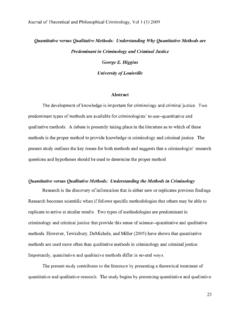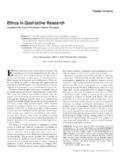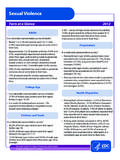Transcription of Crime risk assessment/crime impact assessment
1 Crime risk assessment / Crime impact assessment The related activities described here contribute to a futures- oriented' approach to Crime and its prevention. The future in question could be a 10-year horizon, with wide scope (eg the Crime consequences of the arrival of robot-controlled private vehicles); or perhaps the narrower and more immediate consequences of building a new neighbourhood entertainment complex next year. In each case there will be significant 1 uncertainties, so any forecasting and resultant decisionmaking has to take the form of a range of likely futures within which the proposed policy, practice or products has to be viable and robust. Crime risk assessment (CRA) is an endeavour to systematically and rigorously identify the Crime risks out there' which may face some proposed new entity for which we are responsible: a place (such as a new building), product (eg a new model of car), service (eg a new kind of internet delivery service), business model (eg a new kind of banking) or anything else which could become embroiled in Crime in some way.
2 As with risk in general, the twin tracks of risk are probability of a criminal event occurring and harm from its occurrence (see Risk and Security web page on this site). Crime impact assessment (CIA), like environmental impact assessment , is the counterpart where the focus shifts to considering the criminogenic or criminally harmful consequences of one's own proposals. This is particularly, but not exclusively, relevant to Section 17 of the Crime & Disorder Act England & Wales, which places a statutory duty on a range of local services to do all they can to reasonably prevent Crime and disorder in their area. Crime proofing of a proposed new product, law, service or whatever combines the two perspectives in requiring the identification of Crime risks faced by that new product etc, in relation to the security level incorporated within the product's design (Armitage and Pease 2007; Ekblom and Sidebottom 2007; Clarke and Newman 2005); and the wider Crime consequences of that product (for example making other crimes possible, as with stolen PDAs).
3 Community Safety impact and risk assessments follow the above pattern, except for the obvious substitution. For example: A community safety impact assessment is an attempt, as systematically, rigorously and transparently as possible, to identify the consequences for community safety of undertaking certain actions, offering certain services or pursuing certain policies at a range of geographical levels. Document: Crime risk assessment / Crime impact assessment update: January 2008. Crime prevention and community safety actions can themselves have further impacts on other goals for example excessive street-lighting will have a large carbon footprint;. and badly-designed Crime prevention interventions (such as fortified appearance of buildings/fences) can adversely affect community safety itself. 2 Background A paper for the UK Foresight Programme's Crime Prevention Panel (Ekblom 2000) used the Conjunction of Criminal Opportunity to make systematic links between the 11 causes in that framework and changes in the real world.
4 A subsequent, updated and more reader-friendly version was written up as Future Imperfect' (Ekblom 2002) and is downloadable below. Further aspects were pursued in the field of product design (Ekblom 2005) and forecasting risk and security levels (Ekblom and Sidebottom 2007). References Armitage, R., & Pease, K. (2007) Predicting and preventing the theft of electronic products'. European Journal on Criminal Policy and Research, Clarke, R. and Newman, G. (2005) Secured by Design. A Plan for Security Coding of Electronic Products', in Clarke, R. and Newman, G. (Eds.) Designing out Crime from Products and Systems. Crime Prevention Studies, Vol. 18. Monsey, NY: Criminal Justice Press and Cullompton: Willan Publishing. Ekblom, P (2000) Future Crime Prevention a Mindset Kit' for the Seriously Foresighted. Paper on UK Government Foresight website. Ekblom, P (2002) Future Imperfect: Preparing for the Crimes to Come.' Criminal Justice Matters 46 Winter 2001/02:38-40.
5 London: Centre for Crime and Justice Studies, Kings College. Ekblom, P (2005) Designing Products against Crime ' in N. Tilley (ed.), Handbook of Crime Prevention and Community Safety'. Cullompton: Willan Ekblom, P and Sidebottom, A. (2007) What do you mean, Is it secure?' Redesigning language to be fit for the task of assessing the security of domestic and personal electronic goods.'. European Journal on Criminal Policy and Research. 7c77ffc2dff4994ac9f39a7ad7105bc&pi=11. DOI URL: Document: Crime risk assessment / Crime impact assessment update: January 2008.. Update history: Updates not yet incorporated Updates already incorporated 3.. Doing an impact or Risk assessment on Crime or Community Safety Note: this preliminary version is due to be extended to give concrete examples. Crime impact assessment Doing a CIA involves scrutinising any proposal for action (such as a new product, place, service or even law) in terms of its likely effect in the wider world out there', on the range of known causes and risk factors of Crime , or on the causal influences acting upon the wider sphere of Community Safety.
6 Influencing these causes will affect, for better or worse, the risk of criminal events occurring, or the conditions of community safety being met. To make this process systematic and focused (although it must be said still speculative and qualitative), the consideration of causes and conditions can be structured by applying some of the frameworks of causation described on this website. Principally, these are the Conjunction of Criminal Opportunity (Classic or Dynamic), which covers the immediate causes of criminal events, and the M&S framework, which covers the generic types of Crime risk (the focus can be on Crime in general or on specific categories of Crime ). We can also apply the conditions and benefits listed under the Community Safety definition on this website and the 5Is framework. So, for example, if the Refuse Collection Service of a local council proposes to introduce a new kind of wheelie bin, we can ask: Which of the 11 elements of the CCO might it affect?
7 O Answer 1) Environment makes it easier for offender to climb walls; 2) Enclosure place for offender to hide loot With the Dynamic variant of the CCO framework, we can go into further detail and ask how the various stages of a Document: Crime risk assessment / Crime impact assessment update: January 2008. particular Crime script might be affected (eg seek, see, take, escape, sell). Alternatively, with the M&S framework, we can ask: What kind of role might the bin play in Crime ? o Answer 1) Misappropriation bin itself stolen; 2). Misuse bin used as ladder, hiding place for loot 4. The impact assessment can be taken further by forecasting the wider effects of the Crime and safety consequences in their turn on other policy and practice areas such as sustainability and regeneration. Appropriate policy choices and practical interventions can then be made to resolve or mitigate conflicts and issues that arise. Crime Risk assessment Doing a CRA involves scrutinising any known current state of affairs out there', or some forecast circumstances, in terms of its likely effect on the range of known causes and risk factors of Crime , or the conditions and benefits of community safety.
8 This process can be made more systematic: On the world out there' side, depending on the scope of the assessment , look at any of the changes that might occur in future in the so-called PESSTLE domains (Political, Economic, Social, Scientific, Technological, Legal, Environmental). Changes are typically described as (longer- term) trends or (short-term) events. For each of these changes, ask which of the 11 causes of Crime in the CCO the changes might influence; and which particular kinds of Crime risk (Misappropriation, Mistreatment, Misuse etc) as specified by the M&S. framework. In all cases the assessment is intended to lead to action to manage the risk through: Primary security action reduces probability of harmful event Secondary security if event does happen, action limits harm as it unfolds to product, owner and beyond increases resilience Tertiary security action limits propagation of harm that may occur post-event, eg by preventing further offences such as identity theft following the theft of a credit card Document: Crime risk assessment / Crime impact assessment update: January 2008.
9 risks to the Preventive Process itself Finally, we can use process models such as 5Is to focus on the potential risks to doing Crime prevention and community safety, of some forecast change. For example, some social trend, such as deterioration of relations between police and certain sectors of the public, might jeopardise the Involvement stage of the 5Is process. Likewise we can identify any benefits/enablers for example, the 5 improvements to Intelligence on Crime problems from events such as the arrival of camera phones. Document: Crime risk assessment / Crime impact assessment update: January 2008.





